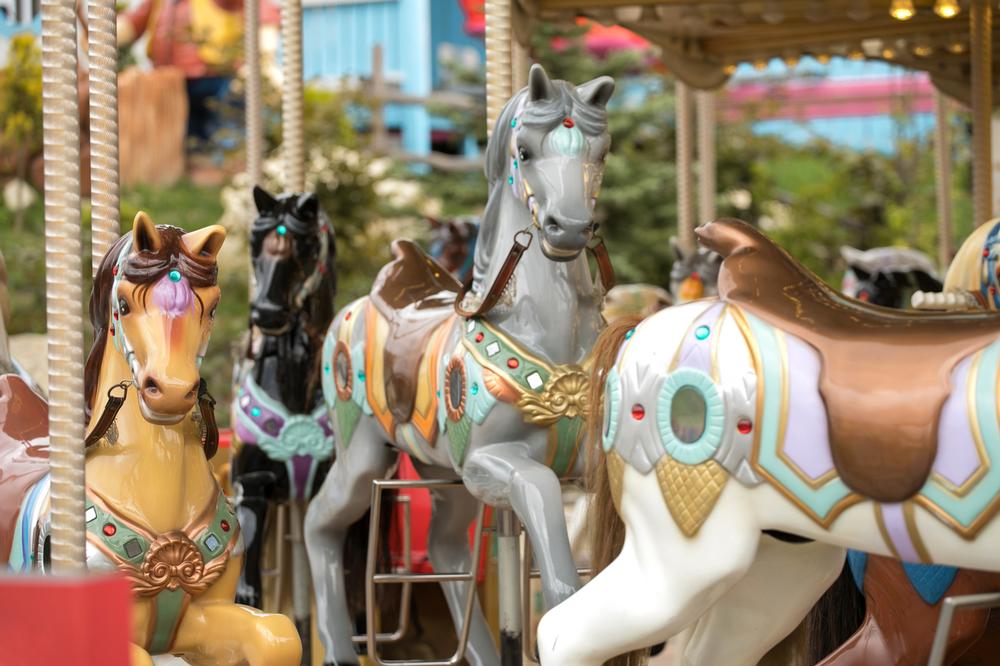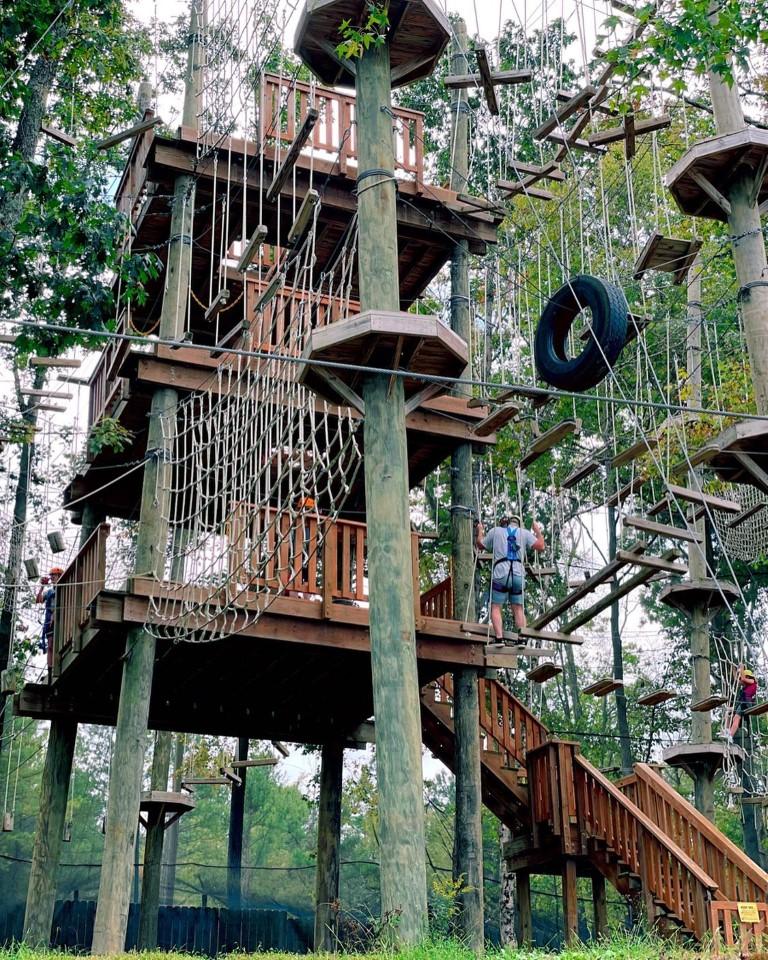In This Article
Craving high-speed thrills and family fun in the Tar Heel State? These exciting amusement parks in North Carolina bring coasters, water rides, and classic fair-style fun perfect for all ages!
Highlights:
- Ride world-class coasters at Carowinds in Charlotte, straddling the NC-SC border.
- Play at Tweetsie Railroad in Blowing Rock, a Wild West-themed park with trains and rides.
- Cool off at Carolina Harbor Water Park, part of Carowinds.
- Discover family-friendly fun and go-karts at Santa’s Land Fun Park & Zoo in Cherokee.
- Explore the vintage charm of the North Carolina State Fair’s midway rides in Raleigh (seasonal).
Unique Amusement Parks in North Carolina
1. Carolina Beach Boardwalk Amusement Park
I like:
"Ride seaside attractions and savor treats on a fun summer trip."

© Courtesy of bravissimos - Fotolia.com
Often considered to be one of the best boardwalks in the United States, Carolina Beach Boardwalk Amusement Park offers a wide variety of classic family fun. The selection of rides includes a Ferris wheel and a carousel, and there are also plenty of arcade games suitable for people of all ages. Donuts, fudge, and other treats are available from the numerous concessions, and the boardwalk is lined with bars and restaurants that provide plenty of after-dark entertainment. Live music is held once a week during the summer, and the show is typically followed by a colorful fireworks display.
100 Cape Fear Blvd, Carolina Beach, NC28428
2. Carowinds - Charlotte
I recommend:
"Scream on thrill rides and cool off in the waterpark on an exciting day."

© Courtesy of Margie Hurwich - Fotolia.com
Conveniently located right off Interstate 77 on the border of North and South Carolina, Carowinds - Charlotte is a is a giant 400-acre amusement park with more than 50 exciting rides for visitors to enjoy.
One of the most popular rides in the park is a 325-foot-tall roller coaster known as the Fury 325, but there are also a dozen other roller coasters as well as plenty of thrilling rides like the Slingshot and kid-friendly rides designed with families in mind. The price of admission also includes access to Carolina Harbor, the 27-acre waterpark nestled inside the park.
14523 Carowinds Blvd, Charlotte, NC 28273, Phone: 704-588-2600
3. Deadwood - Williamston
I love:
"Explore a Wild West town and enjoy rides on an unusual family outing."

© Courtesy of tatsushi - Fotolia.com
Proudly family owned and operated, Deadwood - Williamston is a unique Western theme park with a full-service restaurant and plenty of fun entertainment options for the whole family. Ride options include a classic carousel, a roller coaster, and a train that runs through the park, but visitors can also entertain themselves by heading to the arcade room, playing a round of mini-golf, or by watching one of the live shows that regularly take place on the main stage. The park is open throughout the year, and it's transformed into a spooky Halloween village during the month of October.
2302 Eds Grocery Rd, Williamston, NC 27892, Phone: 252-792-8938
Amusement Parks in North Carolina for Older Kids
4. Frankie's Fun Park
I enjoy:
"Race go-karts and play arcade games on a kids-friendly weekend."

© Courtesy of galitskaya - Fotolia.com
Offering something for everyone, Frankie's Fun Park is an exciting amusement center with enough rides and games to keep the whole family entertained all day. Visitors can get active on the ropes course, in the batting cages, or on the mini-golf course, but they can also immerse themselves in a virtual world in the arcade or on the flight simulator. There is no admission fee to enter the park; instead, visitors pay for each activity as they go. Drinks and snacks are available on-site, and the park is proud to offer birthday party packages with pizza and access to the rides.
1190 Fun Park Dr, Raleigh, NC 27617, Phone: 919-433-7888
5. Jungle Rapids Family Fun Park
I like:
"Splash, slide, and play mini golf on a fun summer trip."

© Courtesy of producer - Fotolia.com
Featuring both a waterpark and a dry park, Jungle Rapids Family Fun Park is a great destination year round. The waterpark offers a large wave pool, a lazy river, a kiddie splash pool, and plenty of exciting slides, while the dry portion of the park features an indoor rock climbing wall, a laser tag arena, a jungle-themed indoor playground, a large arcade, and a snack shack selling tasty food and beverages. Most of the park is open throughout the year, but the water park is only open between late May and early September.
5320 Oleander Dr, Wilmington, NC 28403, Phone: 910-791-0666
6. Santa's Land - Cherokee
I Recommend:
"Ride festive trains and visit Santa on a magical kids-friendly visit."

© Courtesy of wip-studio - Fotolia.com
Found just outside the entrance to Great Smoky Mountains National Park, Santa's Land - Cherokee is a Christmas theme park with plenty of rides, shows, and attractions. One of the biggest highlights is the opportunity to meet Santa, but visitors can also marvel at the animals in the zoo, enjoy the rides, paddle boats around the lake found in the park, and watch exciting live magic shows. The park is open every day between the middle of May until the end of October, and discounted admission is available for birthday parties and groups of 20 or more people.
571 Wolfetown Rd, Cherokee, NC 28719, Phone: 828-497-9191
7. Tweetsie Railroad
I like:
"Board a steam train and explore the Wild West on a family adventure."

© Tweetsie Railroad
Tucked in between Boone and Blowing Rock, Tweetsie Railroad offers Wild West-themed carnival rides surrounded by breathtaking scenery. The selection of rides includes classic favorites like a carousel, a tilt-a-whirl, and a tornado ride, but visitors can also hop aboard one of the park's two historic steam engines, enjoy a meal or a snack from one of the many food vendors, or say hello to the deer and goats in the animal park. Live music and magic shows are held all throughout the day during the summer, and the park is open from the beginning of April through the end of October.
300 Tweetsie Railroad Lane, Blowing Rock, NC 28605, Phone: 800-526-5740
8. Wet'n Wild Emerald Pointe Water Park
I enjoy:
"Zoom down slides and float the lazy river on a summer getaway."

© Courtesy of Alexander Gogolin - Fotolia.com
Visiting a water park is one of the best ways to cool off during a hot North Carolina summer, and the Wet'n Wild Emerald Pointe Water Park offers more than 36 exciting attractions with something for children and adults alike. Highlights include a thrilling open slide with a 76-foot drop and a tube slides with two 360° spins, but there is also a special play area with kiddie slides designed specifically for young children. Plenty of food and drinks are available on-site, and table service is offered to guests who rent one of the park's private cabanas.
3910 S Holden Rd, Greensboro, NC 27406, Phone: 336-852-9721
9. Adventure Landing
I like:
"Play mini golf and enjoy laser tag on an affordable fun trip."

© Zack Frank/stock.adobe.com
Experience fun attractions for visitors of all ages at Adventure Landing , a leading family entertainment center in Raleigh, North Carolina. With several locations around the country, Adventure Landing is a tried and tested institution. Visitors who love sports can head to the Batting Cages, which offer various pitching styles such as fast or slow pitches with both hard and softball options. Meanwhile, there are three fun 18-hole mini golf courses catering to various skill levels. Visitors with a need for speed can head to the quarter-mile-long go-kart track at Adventure Speedway, while competitive guests can challenge other groups in scored combat matches at the Xtreme Fun Laser Tag arena. Game lovers shouldn’t miss the Adventure Landing arcade which boasts over 75 arcade and ticket redemption games.
3311 Capital Boulevard, Raleigh, North Carolina; Phone: 919-872-1688
10. Xtreme Park Adventures
I like:
"Paintball, zipline, and battle in laser tag on an exciting weekend."

© Xtreme Park Adventures
Looking for extreme fun? You’ll find it for sure at Xtreme Park Adventures , a 50-acre adventure center in Durham. With 10 incredible attractions that draw over 30 thousand visitors annually, Xtreme Park Adventure is the ultimate destination in Durham for outdoor adventure and recreation. Arguably its most popular features are the Xtreme Combat Paintball Course and the Xtreme Combat Airsoft Field where intensity and highly competitive rounds ought to be expected. Meanwhile, Xtreme Park Adventures also offers the NC Soccer Field, Rock Climbing, a Ropes Course, and Zipline, as well as ATV Adventures for kids. That’s not all though as there are also Outdoor Quest Adventures, special themed events like the Xtreme Haunt, and even Gem Mining experiences.
7460 Highway 98, Wake Forest Road, Durham, North Carolina 27703; Phone: 919-646-4115
I get asked this a lot so I decided to include it:
- What outdoor activities is North Carolina known for?
- Nestled between the Appalachian Mountains and the Atlantic Ocean, North Carolina is often thought of as a destination for hiking, fishing, and sunbathing on the beach.
- Does North Carolina have amusement parks?
- However, the state is also home to a surprising number of excellent amusement parks suitable for thrill seekers and young children alike.
- What types of attractions do North Carolina amusement parks offer?
- Depending on where your interests lie, you can hop on a scream-inducing roller coaster, pay a visit to Santa in the middle of summer, or spend the afternoon cooling off in a waterpark.
- Which amusement parks should I visit in North Carolina?
- If you're planning a trip to North Carolina, here are the amusement parks you should consider visiting while you're there.
Best Time to Visit Amusement Parks in North Carolina
- June to August – Peak summer season with warm temps and family-friendly excitement.
- July – Busiest month with long hours and vibrant summer vibes.
- April & May – Pleasant spring weather with fewer crowds and shorter wait times.
- September to October – Mild fall temps, perfect for outdoor rides and festive events.
- Early June – Ideal for pleasant weather before peak summer crowds arrive.
How did I do?
Is the article too broad, too narrow, or just right ? Do you like the presentation of photos and text? Let me know in the comments! If you want to see more in this location, I can put it on my editorial calendar. I'm listening!
Plan Your Trip












